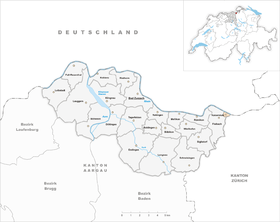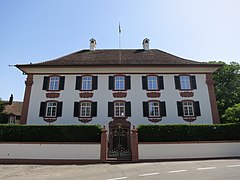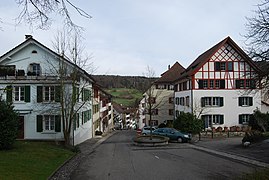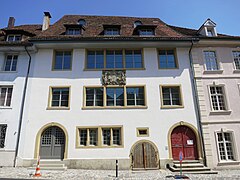Kaiserstuhl AG
| AG is the abbreviation for the canton of Aargau in Switzerland and is used to avoid confusion with other entries of the name Kaiserstuhl . |
| Kaiserstuhl | |
|---|---|
| State : |
|
| Canton : |
|
| District : | Zurzach |
| BFS no. : | 4308 |
| Postal code : | 5466 |
| Coordinates : | 673 741 / 269182 |
| Height : | 341 m above sea level M. |
| Height range : | 332–370 m above sea level M. |
| Area : | 0.32 km² |
| Residents: | 418 (December 31, 2019) |
| Population density : | 1306 inhabitants per km² |
|
Proportion of foreigners : (residents without citizenship ) |
38.8% (December 31, 2019) |
| Website: | www.kaiserstuhl.ch |
|
Old town of Kaiserstuhl seen from the German bank of the Rhine |
|
| Location of the municipality | |
Kaiserstuhl ( Swiss German : ˈχæisərˌʃtuəl ) is a country town and municipality in the Swiss canton of Aargau . It belongs to the Zurzach district and is located on the Upper Rhine on the border with Germany and the canton of Zurich . In terms of area, it is the smallest municipality in the canton and, together with the communities Gottlieben and Rivaz (also 0.32 km²), it is also the smallest municipality in Switzerland.
geography
The municipal area of just 32 hectares includes a steep slope in the north that slopes down to the banks of the Rhine , and in the south an elevated flat plain. 3 hectares are forested and 14 hectares are built over. The highest point is at 368 meters, the deepest at 334 meters. Neighboring communities are Hohentengen in Baden-Württemberg in the north, Weiach in Zurich in the east and Fisibach in Aargau in the west.
history
In his Geographike Hyphegesis , Claudius Ptolemy referred to the place on the Rhine upwards towards the Kaiserstuhl, Prætorium, seu Tribunal Cæsaris op. , Where Tiberius held court, as the Forum Tiberii , the marketplace of Tiberius . Whether this is Bad Zurzach or Kaiserstuhl or a different location has not yet been conclusively clarified. As a commander in Gaul , Tiberius brought with his younger brother Drusus in the years 15 to 13 BC. Chr. By the Rhaetians the Vindeliker under Roman rule. The governor of Gaul, Lucius Plancus Munatius was for some military successes against the Rhaetians north of Lake Constance as Imperator titled.
Nothing precise is known about the origin of the settlement at the southern bridgehead of the Rhine crossing at Rötteln Castle (Rotwasserstelz). Keiserstuol is first mentioned in a document from 1227. The place name comes from the Old High German Keisuresstuol and means "chair of the emperor". The city was founded in 1254 when Baron Rudolf von Kaiserstuhl sold a large part of his free float to the Wettingen monastery . In 1255, Lütold VI. Regensberg the monastery of St. Blaise compensate for two years unjustly from its houses in Kaiserstuhl related charges. It is therefore assumed that the Regensbergers were involved in the founding of the city and later took over the city entirely. When they ran into financial difficulties, they had to sell their property to the Bishopric of Konstanz in 1294 .
Kaiserstuhl then served as the center of the Constance state administration for centuries. The Obervogt residing in Kaiserstuhl exercised the rights of the prince-bishops over Hohentengen , Bergöschingen , Lienheim , Fisibach and Weiach . This gave Kaiserstuhl the status of a country town in the Holy Roman Empire . At the same time, since the conquest of Aargau by the Confederates in 1415 , Kaiserstuhl has also been the center of an external office of the County of Baden , a common rule of the eight old towns . This constellation repeatedly led to conflicts between the prince-bishop and the confederates.
The end of the Ancien Régime after the French invasion and the proclamation of the Helvetic Republic in March 1798 hit the town particularly hard. Due to the Reichsdeputationshauptschluss of 1803, Kaiserstuhl lost all areas of its Efadens on the right bank of the Rhine and thus the lion's share of its territory to the Grand Duchy of Baden, founded in 1806 . The much smaller part on the left bank of the Rhine initially belonged to the canton of Baden and from 1803 to the canton of Aargau. The parts of the municipality east of the city wall were part of Zurich until 1860.
In the middle of the 19th century, the Engelhof vineyards on the right bank of the Rhine (in the area of today's municipality of Hohentengen), now known as the southernmost vineyards in Germany, were predominantly owned by Kaiserstuhl citizens. To this day, Kaiserstuhl has local citizen forest on both sides of the Rhine covering around 150 hectares, almost five times as much as the remaining municipal area on the left bank. The division of property rights of the old parish of Kaiserstuhl, whose parish church used to be in Hohentengen, lasted until 1842. With that, the old parish, which had already been greatly reduced in size with the splitting off of Glattfelden in 1421 and Weiach in the years of the Reformation, was finally lost .
The Swiss Northeast Railway opened the Winterthur – Koblenz line on August 1, 1876 . However, the Weiach-Kaiserstuhl station was a bit off on the other side of the canton border. The SBB closed the station in 1995 and replaced it with a stop right next to the town. In the recent past, Kaiserstuhl has been working more and more closely with the neighboring communities: the fire brigade jointly managed with Fisibach, Wislikofen and Siglistorf, the wastewater treatment plant on the right (northern and thus German) bank of the Rhine operated with the community of Hohentengen.
In 2010, Kaiserstuhl joined the administrative cooperation “Verwaltung2000”, which handles the administrative tasks of seven communities in the neighborhood. The municipality has been involved in the “Rheintal +” project since 2014, which envisages the merger of nine municipalities to form the municipality of Zurzach . After the municipal assembly approved the merger on May 23, 2019 with 59 to 25 votes, the decision was confirmed on September 8, 2019 in a referendum with 79 to 50 votes. This means that the merger will take place on January 1, 2022 (but without Mellikon , which narrowly refused).
Attractions
The compactly built, listed town has the shape of an acute-angled triangle. Today's landmark of Kaiserstuhl, the Obere Turm (often incorrectly referred to as the Römerturm) k was built in the middle of the 13th century and is designed as the southern cornerstone of the city fortifications. It towers over the town and is the only remaining part of the old fortifications. The city walls and the two lower towers on the banks of the Rhine no longer exist. The town is the southern bridgehead of a bridge over the river that was presumably already in existence at the time of the Romans . On the northern bank (in German territory) is the Rötteln Castle , the former seat of the Obervogts.
The origin of the Catholic Church of St. Catherine goes back to the founding of the city. Its mighty choir tower was built around 1300, in which you can see the Gothic tabernacle from the 15th century. In 1609 a new nave was added to the old tower. Around 1700 the interior of the church began to be baroque. The first works by the Zug goldsmith HG Ohnsorg were the two silver busts of Jesus and Mary to the left and right of the high altar. In 1755 the South German artist Eustachius Gabriel painted the new plaster barrel vault with four main pictures and twelve smaller pictures. At the same time, the Kaiserstuhl sculptor Franz Ludwig Wind created his main work, the carved pulpit, the preciously carved baptismal font and, even earlier, the bench cheeks. In 1851 the church received remarkable neo-Gothic altars.
Particularly well-preserved houses are the late Gothic style office building and the Palais Mayenfisch with French building elements. The Haus zur Linde was built in 1764 as the Weisses Kreuz inn . Between 1912 and 1918 the architect Alexander von Senger converted the building into his private country residence.
Statue of Johannes Nepomuk on the Rhine bridge
coat of arms
The blazon of the city's coat of arms reads: "On the right, six columns of blue and red." The oldest representation of the city's coat of arms dates from 1514 and was derived from the coat of arms of the Free of Kaiserstuhl, which, however, had eight instead of six fields. The white of the Prince-Bishop of Constance had also been replaced by the Zurich blue.
population
The population developed as follows:
| year | 1850 | 1900 | 1930 | 1950 | 1960 | 1970 | 1980 | 1990 | 2000 | 2010 |
| Residents | 488 | 366 | 349 | 408 | 398 | 407 | 374 | 433 | 434 | 398 |
On December 31, 2019, 418 people lived in Kaiserstuhl, the proportion of foreigners was 38.8%. In the 2015 census, 35.6% described themselves as Reformed and 28.8% as Roman Catholic ; 35.6% were non-denominational or of other faiths. In the 2000 census, 85.5% said their main language was German , 7.1% Albanian , 2.3% Italian and 2.1% English .
Politics and law
The assembly of those entitled to vote, the municipal assembly , exercises legislative power. The executing authority is the five-member city council . He is elected by the people in the majority procedure, his term of office is four years. The city council leads and represents the community. To this end, it implements the resolutions of the municipal assembly and the tasks assigned to it by the canton. The Zurzach District Court is the first instance responsible for legal disputes . Kaiserstuhl belongs to the XVII (Zurzach) judges' circle.
economy
According to the corporate structure statistics (STATENT) collected in 2015, there are around 100 jobs in Kaiserstuhl, 10% of them in industry and 90% in the service sector. The municipality thus has the highest proportion of employees in the third sector across the canton. Many people in employment are commuters and work in Bad Zurzach and the surrounding area or in the Baden region .
traffic
Hauptstrasse 7 runs between Basel and Winterthur immediately to the south of the town . The Rhine bridge connects Kaiserstuhl with Hohentengen on the opposite bank. The connection to the public transport network is provided by the stop on the Koblenz – Bülach – Winterthur railway line, which opened in 1995 . Kaiserstuhl is the terminus of three postal routes leading to the Baden train station , for Bülach station and airport Zurich lead. On weekends there is a night bus from Oberglatt via Kaiserstuhl to Bachs .
education
Kaiserstuhl owned a school building for the primary school and (until 2009) the district school , but due to declining student numbers and the regionalization of the school organization, it had to be closed in summer 2016. Since then, kindergarten and primary school have been run in the neighboring municipality of Weiach in Zurich , and the upper school can be completed in Stadel . The closest grammar school is the Zürcher Unterland canton school in Bülach .
Culture
From 1980 until his death in 2005, the Icelandic actor Jón Laxdal ran a small theater in the historic cellar vaults of the St. Blasier Amtshaus, which enjoyed great popularity in the region with over 40 productions. After the theater was continued by family members until 2016, the "Kaiserbühne" has since presented an expanded offering.
Personalities
- Franz Beidler (1872–1930), conductor
- Martin Störi (died 1544), Abbey Librarian of St. Gallen
- Hermann Suter (1870–1926), composer and conductor
- Franz Ludwig Wind (1719–1789), sculptor and wood carver
Vivi Bach and Dietmar Schönherr lived in Kaiserstuhl from 1978 to 1990 .
literature
- Franziska Wenzinger Plüss: Kaiserstuhl. In: Historical Lexicon of Switzerland .
- Franziska Hälg-Steffen: Kaiserstuhl, from. In: Historical Lexicon of Switzerland . (Article about the Free of Kaiserstuhl)
- A. Wind: Kaiserstuhl in pictures and history. Einsiedeln, 1894.
- K. Schib: High court and lower court in the episcopal-Constance courts of Kaiserstuhl and Klingnau. In: Argovia, Vol. 43. Aarau 1931, pp. 1-79.
- K. Schib: On the oldest history of Kaiserstuhl. In: Festschrift Friedrich Emil Welti . Aarau 1937, pp. 377-389.
- P. Kläui: Historical overview. In: ders .: The documents of the Kaiserstuhl city archive. Aargau documents, Volume XIII, Kaiserstuhl. Aarau 1955, pp. 9-12.
- M. Hintermann: Around Kaiserstuhl. Kaiserstuhl, Fisibach, Bachs, Weiach, Hohentengen, Herdern, Günzgen, Stetten, Lienheim. [SA of the article series "From Rheinau to Waldshut" in the supplement "Grenzheimat" in the "Zurzacher Volksblatt" 1952–1953]. Zurzach and Oberglatt 1955.
- Franziska Wenzinger Plüss: Kaiserstuhl: Church life in a late medieval small town. In: Argovia, 104: 85-163 (1992).
- Brigitte Frei-Heitz, Franziska Wenzinger Plüss: Kaiserstuhl. (Swiss Art Guide, Volume 710, Series 71). Ed. Society for Swiss Art History GSK. Bern 2002, ISBN 3-85782-710-6 .
- H. Naumann: Kaiserstuhl. On the history of a mountain and a city. Historical research 38. Schäuble Verlag Rheinfelden / Berlin 1997, ISBN 3-87718-244-5 (anthology with several contributions by Naumann from 1962–1970, which appeared for the first time in other publications, relating to Kaiserstuhl AG).
- Herbert Fuchs senior: Hohentengen history and stories taking into account the historical connections to Kaiserstuhl / Switzerland. Verlag Geiger Horb a.Neckar 1992, ISBN 3-89264-716-X .
- Herbert Fuchs senior: Parish of St. Maria from the original parish of Thengen via the parish of Kaiserstuhl-Thengen to the parish of Hohentengen a. High Rhine in modern times.
Web links
- Official website of the municipality of Kaiserstuhl
- Administration2000 (administrative cooperation)
- Burgenwelt: Kaiserstuhl city fortifications
- Illustration by Daniel Meisner from 1624: Keiserstúl; Multos Exsuperare Potes ( digitized version )
Individual evidence
- ↑ Cantonal population statistics 2019. Department of Finance and Resources, Statistics Aargau, March 30, 2020, accessed on April 2, 2019 .
- ↑ Cantonal population statistics 2019. Department of Finance and Resources, Statistics Aargau, March 30, 2020, accessed on April 2, 2019 .
- ↑ a b Beat Zehnder: The community names of the canton of Aargau . In: Historical Society of the Canton of Aargau (Ed.): Argovia . tape 100 . Verlag Sauerländer, Aarau 1991, ISBN 3-7941-3122-3 , p. 216-218 .
- ↑ Standard area statistics - municipalities according to 4 main areas. Federal Statistical Office , November 26, 2018, accessed on June 18, 2019 .
- ^ National map of Switzerland, sheet 1051, Swisstopo.
- ↑ Cicero, In M. Antonium oratio Philippica 3, 38; Acts of triumph; CIL 6, 1316 and 10, 6087.
- ↑ About us. Verwaltung2000, accessed June 18, 2019 .
- ^ Philipp Zimmermann, Andreas Fretz, David Rutschmann: Grossfusion im Zurzibiet: 9 municipalities say yes to «Zurzach» - Fisibach refuses to join. Aargauer Zeitung , May 24, 2019, accessed on June 17, 2019 .
- ↑ Pirmin Kramer, Daniel Weissenbrunnen: Zurzibieter large merger is perfect! Eight municipalities say yes, only Mellikon refuses. Aargauer Zeitung , September 8, 2019, accessed on September 10, 2019 .
- ^ Schloss Kaiserstuhl (upper tower). swisscastles.ch, accessed on January 25, 2010 .
- ↑ Gallery: Photos of beautiful old coats of arms No. 1302
- ^ Joseph Galliker, Marcel Giger: Municipal coat of arms of the Canton of Aargau . Lehrmittelverlag des Kantons Aargau, book 2004, ISBN 3-906738-07-8 , p. 187 .
- ↑ Population development in the municipalities of the Canton of Aargau since 1850. (Excel) In: Eidg. Volkszählung 2000. Statistics Aargau, 2001, archived from the original on October 8, 2018 ; accessed on June 18, 2019 .
- ↑ Resident population by religious affiliation, 2015. (Excel) In: Population and Households, Community Tables 2015. Statistics Aargau, accessed on June 18, 2019 .
- ↑ Swiss Federal Census 2000: Economic resident population by main language as well as by districts and municipalities. (Excel) Statistics Aargau, archived from the original on August 12, 2018 ; accessed on June 18, 2019 .
- ↑ circles of justice of the peace. Canton of Aargau, accessed on June 18, 2019 .
- ↑ Statistics of the corporate structure (STATENT). (Excel, 157 kB) Statistics Aargau, 2016, accessed on June 18, 2019 .
- ↑ Manuel Navaro: New theater inherits Laxdal stage. Zürcher Unterländer , April 21, 2017, accessed on April 3, 2019 .















